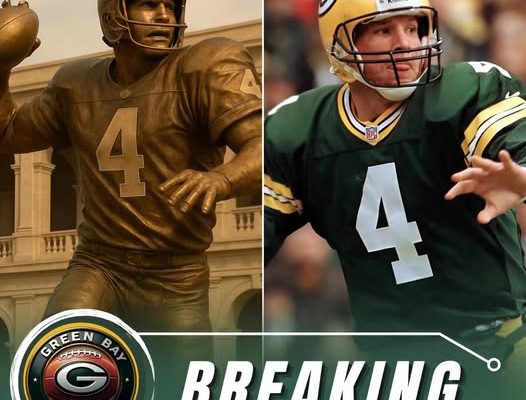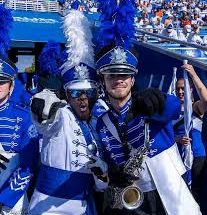In a move that has sent waves of excitement across the NFL community and rekindled a treasure trove of memories for Green Bay Packers fans, the organization has announced that it will be erecting a \$2.5 million statue of Hall of Fame quarterback Brett Favre outside the historic Lambeau Field. This monumental tribute to one of the most iconic players in the team’s storied history is both a celebration of Favre’s legendary accomplishments and a symbolic gesture of reconciliation and legacy-building between the franchise and its former star.
For decades, Brett Favre embodied everything that Packers football represented. Toughness, resilience, competitive fire, and an uncanny ability to deliver in the biggest moments were the hallmarks of his career. From his arrival in 1992 via a trade from the Atlanta Falcons to his emotional departure in 2008, Favre led the Packers through a renaissance that saw them rise from mediocrity to Super Bowl champions and perennial contenders. He holds numerous franchise and NFL records, including a streak of 297 consecutive starts—a testament to his iron-man durability. Favre’s arm, improvisation, and passion for the game made him a fan favorite and one of the most entertaining quarterbacks in league history.
The Packers’ decision to immortalize Favre in bronze is more than a simple nod to his on-field achievements. It is a clear statement that the organization values his legacy as a cornerstone of modern Packers football. For years, the relationship between Favre and the Packers had been strained due to the contentious way his tenure ended, involving a retirement, an attempted return, and eventual stints with the New York Jets and the rival Minnesota Vikings. However, recent years have seen a thaw in that relationship, with Favre being inducted into the Packers Hall of Fame in 2015 and having his number 4 jersey retired in an emotional ceremony that saw thousands of fans return to Lambeau to pay tribute to their quarterback hero.
This statue, which will reportedly be constructed by a renowned sculptor specializing in sports monuments, will stand near other iconic Packers memorials outside Lambeau Field, such as those dedicated to Vince Lombardi and Curly Lambeau. The placement is intentional—it signals that Favre belongs among the immortal figures who defined the franchise and influenced generations of football fans. According to team president Mark Murphy, the decision to fund the statue with \$2.5 million is both a financial investment and a cultural one. “Brett Favre changed the trajectory of this organization. He made us relevant again. We feel it’s time his greatness is permanently enshrined where it belongs—right here at Lambeau,” Murphy said in the official press release.
Fans and former players have reacted with overwhelming support. Many took to social media to express their excitement and appreciation for the gesture. Hall of Fame quarterback and former teammate Steve Young praised the Packers for acknowledging Favre’s impact, calling him “a once-in-a-generation leader who gave everything he had every Sunday.” Meanwhile, Aaron Rodgers, Favre’s successor and fellow Packers legend, posted a message on his Instagram story applauding the move and calling Favre “one of the greats, period.”
While Favre’s career wasn’t without its controversies, particularly toward the end, the overall body of work is undeniably historic. Under his leadership, the Packers won Super Bowl XXXI, made multiple playoff appearances, and returned to national prominence. Favre won three consecutive NFL MVP awards from 1995 to 1997—an unprecedented feat at the time—and was selected to 11 Pro Bowls. His gunslinger mentality, while sometimes risky, brought a level of excitement to the game that few others could match. Whether threading a ball into tight coverage or scrambling to make an improbable throw on the run, Favre brought Lambeau Field to life every time he took the field.
What makes this statue particularly meaningful is that it represents a full-circle moment in Favre’s relationship with Green Bay. After retiring and unretiring multiple times and then joining the Vikings—an act that felt like betrayal to many fans—Favre was at risk of being remembered as a complicated figure. But time, maturity, and reflection have allowed both the organization and its fanbase to separate emotion from legacy. Today, most Packers fans choose to remember the joy, hope, and energy Favre brought to Sundays, rather than the drama of his departure. This statue serves to reinforce that narrative, placing Favre firmly within the pantheon of all-time greats who built Green Bay into what it is today.
The \$2.5 million price tag also sparked discussion, with some questioning the use of such funds for a statue. However, sources close to the organization say that private donors and the Packers’ legacy fund will cover the majority of the cost. This fund, created to maintain the cultural and historical aspects of the team’s identity, is seen as the perfect financial source for such a landmark tribute. It ensures that the statue will not only be a beautiful piece of art but a community-backed emblem of pride and tradition.
Construction is set to begin in early 2026, with the unveiling likely to occur before the start of the regular season. Plans for the ceremony are already underway, and insiders suggest it will be a grand affair, featuring past players, celebrities, and thousands of fans. Favre himself is expected to be heavily involved in the design process, reportedly working closely with the artist to ensure the statue captures the essence of his persona—gritty, passionate, and unrelentingly competitive. One source noted that Favre insisted the statue depict him mid-throw, with that signature determined look on his face, symbolizing his commitment to every down, every game.
Beyond the statue itself, the Packers are also planning to launch a mini-museum exhibit inside Lambeau Field showcasing Favre’s most iconic moments—game-worn jerseys, MVP trophies, highlight reels, and even personal letters and memorabilia. It will serve as both an educational experience for new generations of fans and a nostalgic journey for those who lived through Favre’s era. This is not just about a statue—it’s about storytelling, legacy-building, and cementing a cultural icon within the physical and emotional landscape of Green Bay.
Favre, who has been increasingly active in NFL circles as a speaker and commentator, released a brief statement through his agent following the announcement: “I’m honored and humbled by this news. Playing for Green Bay was one of the greatest chapters of my life, and to be remembered this way, outside the very stadium where so many memories were made, means the world to me and my family. Thank you, Packers fans. You are the best in the world.”
Indeed, for the fans who braved frigid Wisconsin winters just to see Favre make magic on the frozen tundra, this statue is a tribute not only to the quarterback but to the bond between a city and its sports hero. It’s a reminder that greatness is forged through sacrifice, perseverance, and an unwavering belief in the impossible. It immortalizes not just a player, but a spirit—a wild, joyous, defiant spirit that refused to quit and always believed it could win.
As the project moves forward, excitement continues to build. Local businesses are already preparing for an influx of visitors during the unveiling weekend, and Green Bay’s tourism office is working with the Packers to ensure the event is as memorable as the man it honors. Some fans are even suggesting that August 4th—8/4, representing his iconic jersey number—be declared “Brett Favre Day” in Wisconsin, a proposal that has gained traction on social media and in local government circles.
In the end, the statue will stand not just as a monument to Brett Favre, but as a symbol of what sports can mean to a community. It is about memory, pride, triumph, heartbreak, forgiveness, and love. It is about that rare kind of player who, for a time, carried the hopes of millions with nothing but a football in his hand and fire in his heart. And in Green Bay, where football is a religion and Lambeau Field is its cathedral, Brett Favre’s likeness will now stand forever—cast in bronze, etched in legend, and cherished in the hearts of fans for generations to come.



